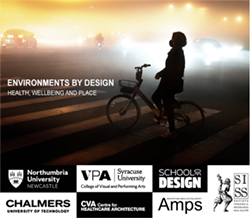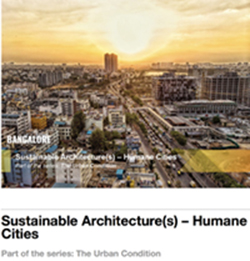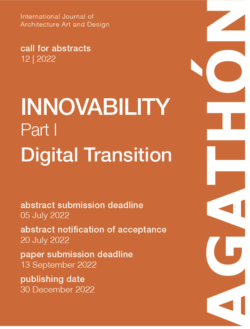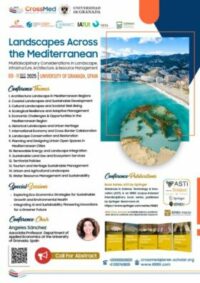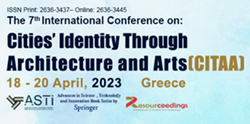ISSN (online): 2076-3298
Call of the Journal:
- Dynamic of Vegetation and Climate Change
- Environmental Implications of COVID-19 Pandemic
- Environmental Sustainability – Life Cycle Assessment – Energy and Environmental Technology
- Groundwater Quality and Groundwater Vulnerability Assessment
- Indoor and Outdoor Air Particulate Matter
- Monitoring and Assessment of Environmental Quality in Coastal Ecosystems
- Monitoring and Management of Inland Waters
- Multiple Approaches for Environmental Assessment of Transitional and Coastal Waters
- Plastic Contamination | Challenges and Solutions
- Response to Current Air Quality Changes in Small and Large Areas
- Restorative Agriculture
- Risk Assessment for Workplace Exposure to Natural Radioactivity
- Rural-Urban Relations and Sustainable Food Systems
- Soil Pollution Assessment and Sustainable Remediation Strategies
Jul
2021
According to the European Environment Agency’s 2019 Air Quality Report, cities represent an environment characterized by many emission sources that significantly contribute to the daily total particle exposure for humans. Due to population growth, the economy and industrial production are concentrated in urban areas, which leads to a high level of urban transport. In particular, urban freight transport is another contributor to greenhouse gas emissions and air pollution. Airborne particle concentration levels in cities are mostly related to anthropic urban activities/sources, such as industrial and residential sectors (heating) and vehicular traffic, i.e., sources characterized by combustion processes mainly producing high levels of particulate matter (PM), sub-micrometric, and ultrafine particles. Recent epidemiological studies have demonstrated that exposure to these concentrations can lead to respiratory and circulatory health problems. The International Agency for Research on Cancer (IARC) has classified particulate matter, a major component of air pollution, as carcinogenic to humans (Group 1). Different measures should be taken regarding vehicle technologies, distribution optimization, and regulations. Furthermore, some policies and interventions, such as the promotion of sustainable urban mobility actions (such as different urban transport strategies ranging from car-pooling, expanded electric vehicle (EV) use to bike-sharing) are needed to improve urban air quality and to reduce the impact of such sources on the urban environment in terms of human exposure. Air pollution in industrial areas is still a topic of great health and social relevance. In the last few decades, conventional industrial processes (e.g., concrete, steel, and plastic production, waste incineration, and thermoelectric energy generation) have undergone several changes to mitigate their environmental burden. Nevertheless, such processes are still a major source of air pollutants. On the other hand, novel industrial processes related to a circular economy (waste recycling, biomaterials production, renewable energy generation, etc.) are experiencing rapid growth; while their global impact on climate change mitigation is well known, little information is available on their local impact on air quality. In this framework, new research is needed to provide updated information on air pollutant emissions in urban and industrial areas. Interest can be focused on regulated pollutants or emerging pollutants, including volatile organic compounds, polyaromatic, halogenated, flame retardants, siloxanes, greenhouse gases, biologically active molecules, and nanoparticles. This Special Issue is open to the subject area of urban and industrial air pollution. The keywords listed below provide an outline of some of the possible areas of interest.
Keywords: Air pollution; NOx; Particulate matter; Residential heating; Road traffic emissions; Sustainable mobility; Industrial emissions; Pollutant dispersion; Outdoor air quality; Global health; Population exposure.
Air Pollution in Urban and Industrial Areas
According to the European Environment Agency’s 2019 Air Quality Report, cities represent an environment characterized by many emission sources that significantly contribute to the daily total particle exposure for humans. Due to population growth, the economy and industrial production are concentrated in urban areas, which leads to a high level of urban transport. In particular, urban freight transport is another contributor to greenhouse gas emissions and air pollution. Airborne particle concentration levels in cities are mostly related to anthropic urban activities/sources, such as industrial and residential sectors (heating) and vehicular traffic, i.e., sources characterized by combustion processes mainly producing high levels of particulate matter (PM), sub-micrometric, and ultrafine particles. Recent epidemiological studies have demonstrated that exposure to these concentrations can lead to respiratory and circulatory health problems. The International Agency for Research on Cancer (IARC) has classified particulate matter, a major component of air pollution, as carcinogenic to humans (Group 1). Different measures should be taken regarding vehicle technologies, distribution optimization, and regulations. Furthermore, some policies and interventions, such as the promotion of sustainable urban mobility actions (such as different urban transport strategies ranging from car-pooling, expanded electric vehicle (EV) use to bike-sharing) are needed to improve urban air quality and to reduce the impact of such sources on the urban environment in terms of human exposure. Air pollution in industrial areas is still a topic of great health and social relevance. In the last few decades, conventional industrial processes (e.g., concrete, steel, and plastic production, waste incineration, and thermoelectric energy generation) have undergone several changes to mitigate their environmental burden. Nevertheless, such processes are still a major source of air pollutants. On the other hand, novel industrial processes related to a circular economy (waste recycling, biomaterials production, renewable energy generation, etc.) are experiencing rapid growth; while their global impact on climate change mitigation is well known, little information is available on their local impact on air quality. In this framework, new research is needed to provide updated information on air pollutant emissions in urban and industrial areas. Interest can be focused on regulated pollutants or emerging pollutants, including volatile organic compounds, polyaromatic, halogenated, flame retardants, siloxanes, greenhouse gases, biologically active molecules, and nanoparticles. This Special Issue is open to the subject area of urban and industrial air pollution. The keywords listed below provide an outline of some of the possible areas of interest.
Keywords: Air pollution; NOx; Particulate matter; Residential heating; Road traffic emissions; Sustainable mobility; Industrial emissions; Pollutant dispersion; Outdoor air quality; Global health; Population exposure.
AGRICOLA (National Agricultural Library), AGRIS Agricultural Sciences and Technology (FAO), DOAJ, Emerging Sources Citation Index – Web of Science (Clarivate Analytics), Genamics JournalSeek, GeoRef (American Geosciences Institute),Norwegian Register for Scientific Journals, Series and Publishers (NSD), Scopus (Elsevier) Web of Science (Clarivate Analytics), CLOCKSS (Digital Archive), e-Helvetica (Swiss National Library Digital Archive), Academic OneFile (Gale/Cengage Learning), Google Scholar J-Gate (Informatics India), ProQuest Central (ProQuest), Science In Context (Gale/Cengage Learning), WorldCat (OCLC).
Info at: www.mdpi.com/journal/environments/apc
Guest Editors
Dr. Francesco Petracchini
Dr. Valerio Paolini
Dr. Valeria Rizza


